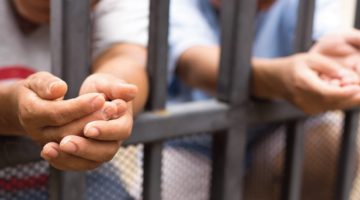California passed a bill on Oct. 12 banning private prisons as of 2028, spotlighting, once again, America’s obsession with locking up human beings. The situation is worse than many may think.
Around 2.2 million people are in prison and another 4.3 million on parole or probation, for a total of 6.5 million. The United States has five percent of the world’s population but 21 percent of its prisoners. The overall cost could be as high as $182 billion, German Lopez wrote on Vox.
African Americans comprise about 12 percent of the U.S. population, number 2.3 million or 34 percent of the 6.3 million total, are imprisoned at more than five times the rate for whites and their women at twice the rate for white women, the NAACP reported.
Their males aged 18 to 19 are nine times more likely to be imprisoned than their white counterparts, Amnesty International said.
The demand to control those millions spawned a “prison industrial complex,” as Angela Davis called it, including private prisons which housed 8.2 percent or 121,000 prisoners in 2017, the Bureau of Justice Statistics reported. That was a 47 percent increase between 2000 and 2016, or five times the rate of the overall prison population, the Sentencing Project said. Twenty-seven states and the federal government use them and concerns about their operations have attracted the attention of leading Democratic presidential candidates.
Bernie Sanders said they have “racist roots in American chattel slavery.” Cory Booker described them as “repugnant.” Kamala Harris and Elizabeth Warren would ban them. A few banks, large institutions and pension funds have divested from them. The Obama administration began phasing them out at the federal level in 2016 but President Donald Trump’s then Attorney General Jeff Sessions reversed that policy in 2017.
Private companies are even more entrenched in providing services to prisons. The Nation’s Tim Requarth gave some examples of the annual take: food service, $4 billion; health care, $6 billion; telephone services, $1.3 billion – a 15minute call could cost $25; transportation; video conferencing; emails; bank transfers; and ankle monitors for which the wearer must pay up to $300 each and a monitoring fee.
It is generally believed that the private prison trend began with President Ronald Reagan’s “War on Drugs” in the 1980s but Morgan Simon, writing in Forbes, traced it to Terrel Don Hutto, who, in the 1960s, operated a cotton plantation in Texas using mostly unpaid African American prison labor. Hutto eventually founded Corrections Corpo ration of America, now known as CoreCivic and valued at $1.8 billion.
The GEO Group, founded in 1984 by former FBI agent George Wackenhut and three colleagues, started as Special Agent Investigations in Coral Gables. The company can now hold 96,000 detainees in 135 facilities in the U.S., Australia, South Africa and the U.K., is now headquartered in Boca Raton, has 23,000 employees and is worth $2.5 billion.
Florida ranks 14th among states in number of prisoners — 833 for every 100,000 residents and 49 percent of them African Americans. The state operates the third largest prison system, including eight privately owned prisons, five of them by the GEO Group, Amnesty International reported. The number of prisoners held in private Florida facilities rose from 3,812 in 2000 to 12,176 in 2016 or by 211 percent, Jerry Iannelli reported in New Times.
The Marshals Service started using private prisons to handle an increase of 100,000 people annually in the 1990s to 200,000 in 2016. The Bureau of Prisons has about 21,000 or 11 percent of its total number of inmates in such prisons. And the newest private sector money-maker is the massive detention demands of Immigration and Customs Enforcement.
Private equity firms play a major role. One of them, HIG Capital, based in Miami, with assets of more than $30 billion, “has quietly helped consolidate correctional phone, food, commissary and health-care companies into behemoths that dominate their markets and, according to critics, drive prices up for families while lowering quality,” Requarth reported.
Then there are ankle monitors. USNewsBeat.com said more than 200,000 people are required to wear them, a 150 percent increase over the past 10 years.
Michelle Alexander, who raised the alarm about the wholesale imprisonment of African Americans with her 2010 book “The New Jim Crow – Mass Incarceration in the Age of Colorblindness,” called attention to this “e-carceration” in a New York Times column.
Private corporations, Alexander said, benefit the most, especially the GEO Group, which has contracts in 30 states, earning more than $200 million annually just for monitoring services. These “digital prisons are to mass incarceration what Jim Crow was to slavery.” She added, “A growing number of activists predict that ‘e-gentrification’ is where we’re headed as entire communities become trapped in digital prisons that keep them locked out of neighborhoods where jobs and opportunity can be found.”
James Kilgore, who had to wear a monitor for a year, writing on Truthout, traced the origins of electronic monitoring to slavery, when “enslavers kept meticulous track of their ‘property’, branding Black people with their plantation logo as a tool of surveillance and control. While tracking is not new, the technology is.”
Or as French writer Jean-Baptiste Alphonse Karr said in 1849, “the more things change, the more they stay the same.”













No Comment